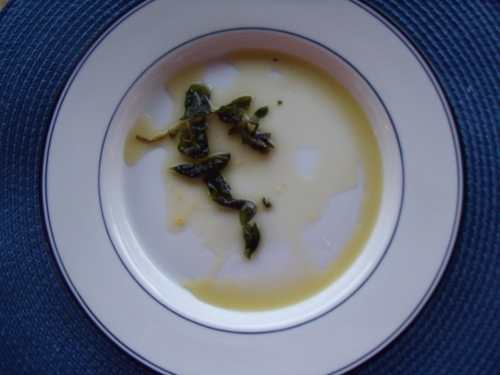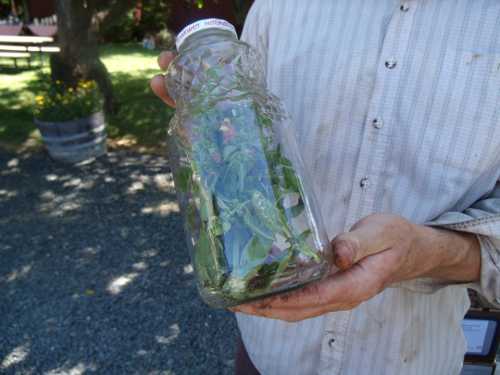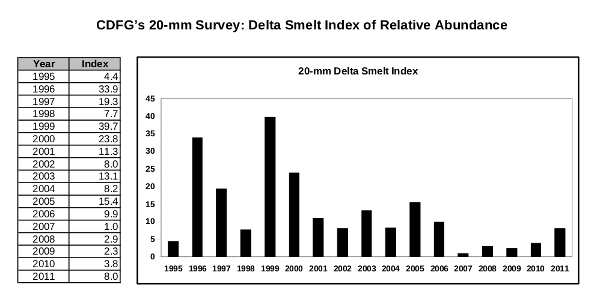
This basil at the Lake County Farmers' Finest market at Steele Winery in Kelseyville, Calif. on July 23, 2011, was grown by Full Moon Farms. Photo by Esther Oertel.
I love the scent of fresh basil leaves; in fact, of all the aromas in the world, basil ranks high among my favorites, right up there with coffee beans, newly-mown grass and warm-from-the-oven homemade bread.
This is the time of year when mounds of freshly plucked basil leaves – as well as basil plant starts for home gardens – are available at local farmers’ markets. The short-lived abundance of this seasonal herb is one of the reasons for the subject of my column this week.
The other is that a couple of readers asked me to write about it.
Having covered the topic last summer at about this time, I was hesitant to comply at first. I worked to overcome that reluctance, however, since I do like to please my readers and it would be impossible to have covered all there is to know about basil in just one column. (It is the king of summer, after all!)
As most home gardeners know, there are many types of basil.
There are sweet and Genovese basils that are the darlings of Italian cuisines, the types found at most farmers’ markets and grocery stores.
There is strongly flavored Thai basil used in Southeast Asian cooking.
There are basils infused with the scents and flavors of things like licorice, anise, clove, lemon, lime, camphor or cinnamon.
There are those named for areas of the world such as Greece, Cuba and Africa, or basils whose monikers reflect a physical characteristic, like mammoth or purple ruffles.
And then there are those with names that make you scratch your head a little, like Magical Michael.
Oh, how I love them all! From bright green and shiny to dark purple, the flavorful leaves of this plant have made it one of the most popular herbs in the world.

This basil oil, shown here with crispy basil leaves, is made by infusing fresh basil leaves in warm olive oil. In addition to flavoring sauces and dressings, basil oil may be used as a drizzle or dip for bread. Photo by Esther Oertel.
Basil is thought to have originated in India, as the most ancient references to it are found there; however, some believe it hails from further east, in the Hunan region of China, which also has ancient references to the plant.
Either way, throughout history, basil has been associated with much folklore, some of it conflicting, with the lion’s share related to love.
One of the most interesting things I read related to such basil mythology is that it was thought to be a charm in ancient Rome against the basilisk, a fire-breathing beast brought to recent fame via the literary world of Harry Potter.
Whether or not basil can banish dragon-like creatures, medicinally it’s known to be a fighter. In fact, the volatile oil obtained from its leaves has been shown to inhibit several species of pathogenic bacteria that have become resistant to antibiotic drugs.
In addition, basil has active components known as flavonoids that protect cell structures and chromosomes against damage, whether oxygen-based or from radiation.
Basil is known for promoting cardiovascular health through its high concentration of vitamin A in the form of beta-carotene. It also has good stores of magnesium, which is helpful to the heart through improving blood flow.
Basil is considered a very good source of iron and calcium, and a good source of potassium and vitamin C.
It would seem that enjoyment of this herb is beneficial to more than just our palate.
In this country, basil is most closely associated with Italian cuisine, and the basil commonly available to us is that which is used in the foods of that region.
The thought of such dishes as bruschetta, with diced fresh tomatoes, basil, garlic and olive oil over toasted slices of Italian bread, or pasta pomodoro, with its magnificent combination of fresh tomatoes, basil-infused olive oil, and garlic as a sauce for pasta, can make my mouth water.
To be honest, almost any combination of tomatoes and basil can do that to me, whether it’s a tomato-basil sandwich or a lovely dish of garden-fresh tomatoes sliced and layered between basil leaves, fresh mozzarella and drizzled olive oil.
Basil is the key ingredient of pesto, a most delicious sauce with its origins in northern Italy, specifically Genoa. This beautiful green paste infuses pasta and other dishes with pungent basil and can be made by blending basil with olive oil, garlic, and pine nuts.
Since fresh basil tends to lose its flavor when cooked, it’s best to add it to dishes at the last minute, after cooking is completed. (Toss it into a pasta sauce just before you pull it off the stove, for example.)
One way to preserve the flavor of basil is to make an herb-infused olive oil. Oils and fats are flavor carriers, and once basil has released its essence into the olive oil, it’s locked in.
I often use basil-infused oil as a way flavor sauces and other dishes. As a bonus, such oil is a great alternative to butter because it’s a fantastic dip for bread, especially when combined on a plate with a splash of balsamic vinegar.
To make infused oil, toss a healthy handful of basil leaves into a good amount of olive oil in a saucepan (about ½ to one cup of basil leaves to about the same amount of oil).
Allow the oil to come to a simmer, then turn the heat off and let it sit for 30 minutes or so on the still-warm burner.
Strain the oil into a container and store it in the fridge, where it should keep well for at least a week or two.
For additional flavor, garlic cloves and/or red pepper flakes may also be added to the oil (something I do when I make pasta pomodoro). This method may be used to infuse the flavor of any herb into oil (for example, rosemary or thyme).
The basil leaves and other goodies left after the infusion may be pureed and stored in the fridge to flavor to a variety of other foods, from mashed potatoes to minestrone soup to salad dressing.
Crispy basil, a garnish for Italian soups and other dishes, can be made in a similar way; however, a skillet should be used rather than a saucepan and the oil should be heated before the basil is tossed in.
Be cautious, as the basil will bubble and pop once it hits the oil. When the basil is crispy, turn off the heat and remove the leaves from the oil.
In addition to the crispy basil leaves, a basil-infused olive oil has been created.
Though we most often think of basil to flavor savory foods, it also has a place in sweeter fare.

Lake County farmer Sean Mooney displays a drink made by adding sprigs of fresh flowering basil to water. Mooney enjoys this concoction for its flavor, as well as for its health benefits. Photo by Esther Oertel.
Thinly sliced basil is a pleasant surprise ingredient for fruit salads, especially those that include strawberries, peaches or nectarines, and sweet syrup made with basil may be drizzled over desserts made with components such as lemon or mango.
A quick Internet search revealed some pretty interesting desserts made with basil: chocolate-basil ice cream, basil-poached pears and watermelon-basil granita, to name a few.
The recipe for today is a refreshing drink made with basil and mint. These two relatives in the plant kingdom complement one another well.
The basil-mint syrup may also be used for things such as sparkling lemonade (one part syrup, one part freshly-squeezed lemon juice and two parts sparkling water) or as a topping for pancakes with strawberries.
If basil syrup without mint is desired, increase the amount of basil to replace the mint. Lemon-basil syrup may be made by adding a generous piece of lemon peel to infuse with the basil.
For those who wish to avoid sugar, use stevia, honey or agave nectar in place of the sugar.
Enjoy!
Summertime basil-mint cooler
½ cup loosely paced fresh basil leaves
½ cup loosely packed fresh mint leaves
Cup sugar
Cup water
Sparkling water or club soda
Ice
First, make the syrup:
Combine sugar and water in a saucepan. Heat to a simmer on stove top and cook, stirring occasionally, until sugar is completely dissolved and mixture is clear. Remove from heat and cool just a little so it’s still warm, but not overly hot.
Place the basil and mint in a container and pour the warm syrup over. Cover and refrigerate for at least two hours for flavors to infuse (or overnight).
If desired, remove herbs from simple syrup once flavor is infused. (I like keeping them in the syrup and sometimes put them in the glasses when I make the coolers.)
Leftover syrup should be stored in the refrigerator in a covered container.
To make the cooler, add two to three tablespoons of syrup to a glass, add ice and pour about a cup of sparkling water in. Stir and garnish, if desired, with sprigs of fresh basil or mint.
Recipe by Esther Oertel.
Esther Oertel, the “Veggie Girl,” is a culinary coach and educator and is passionate about local produce. Oertel teaches culinary classes at Chic Le Chef in Hidden Valley Lake, Calif., and The Kitchen Gallery in Lakeport, Calif., and gives private cooking lessons. She welcomes your questions and comments; e-mail her at This email address is being protected from spambots. You need JavaScript enabled to view it..
Follow Lake County News on Twitter at http://twitter.com/LakeCoNews, on Tumblr at www.lakeconews.tumblr.com, on Facebook at http://www.facebook.com/pages/Lake-County-News/143156775604?ref=mf and on YouTube at http://www.youtube.com/user/LakeCoNews.




















